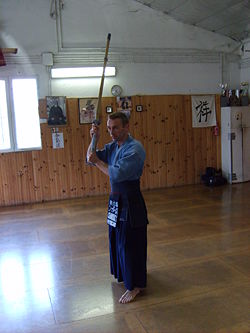- Hassō-no-kamae
-
Hassō-no-kamae
Garde hasso au kendo.Nom Japonais Kanji: 八相(八双)の構 Hiragana: はっそうのかまえ Hassō-no-kamae (八相(八双)の構, はっそうのかまえ?), couramment simplifié en hassō, et quelques fois appelé hassō-gamae, est l'une des cinq gardes du kendo, avec jōdan, chūdan, gedan, hassō, and waki. Hasso est une garde offensive, le nom hassō "signifiant toutes les (huit) directions", vu que cette gardes permet de répondre à un danger, peu importe la direction d'où il vient. Waki and hassō ne sont généralement pas utilisé en kendo morderne et ne se retrouvent que dans les katas (kata 4).
La garde hassō-no-kamae s'effectue en avançant le pied gauche, et en pointant le bokken vers le haut, le poignet droit au niveau de l'oeil droit, et la poignée de l'arme (tsuba) au niveau de l'épaule droite. La lame doit très légèrement pointer vers l'arrière. La frappe peut s'effectuer soit au-dessus de la tête, comme en jōdan[1].
hassō-no-kamae est utilisée par uchidachi dans le quatrième kata du Kendo, faisant face à la garde Waki-no-kamae de shidachi[2]. Cette garde est également utilisée en Naginata.
Hassō est également appelée in-no-kamae (陰の構え, いんのかまえ?) ("garde de l'ombre") en Ittō-ryū. Elle est appelée Hassō (八相:はっそう?) en Shinkage-ryū et aussi appelée moku-no-kamae (木の構え, もくのかまえ?) ("garde de bois"), car cette garde ressemblerait à un arbre[3].
Références
- 上野 靖之 (1966) 剣道教典 (Educational Model Fencing) 尚武館刊. p317
- (en) Junzo Sasamori, Gordon Warner, This is Kendo, Japan, Charles E. Tuttle, 1964 (ISBN 978-0-8048-0574-2) (OCLC 225057658)
- 上野 靖之 (1966) 剣道教典 (Educational Model Fencing) 尚武館刊.p317
Sources
- (en) Cet article est partiellement ou en totalité issu de l’article de Wikipédia en anglais intitulé « Hassō-no-kamae » (voir la liste des auteurs)
- Portail arts martiaux et sports de combat
Wikimedia Foundation. 2010.

